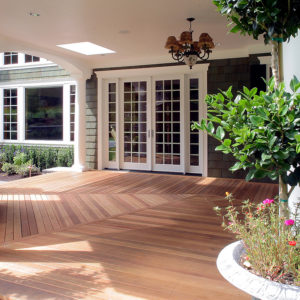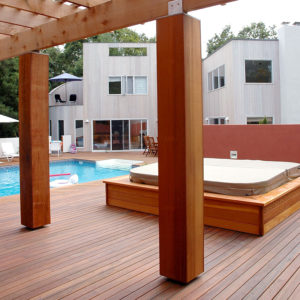The Beauty of Cedar: A Buyer’s Guide to Western Red Cedar Decking
What is Western Red Cedar Decking?

Western Red Cedar is a species of wood native to the western region of North America. Named for its distinct reddish hue, it is known for its straight grain, uniform texture and unique aroma. It possesses a beautiful palette of rich, warm colors ranging from light amber to deep honey brown.
Its natural allure makes it a popular choice for various construction projects beyond decking, including siding, roofing, paneling and fencing. Moreover, Western Red Cedar is less dense compared to many other wood species, which makes it easier to handle and shape according to specific design requirements.
Unique Properties and Benefits of Western Red Cedar Decking

Western Red Cedar decking offers a unique blend of benefits that set it apart from other decking materials:
Natural Beauty
The vibrant, reddish-brown color of Western Red Cedar turns any deck into a beautiful outdoor living space. Its grain is tight and straight, which creates a uniform, polished look on the deck surface.
Durability
Despite its lightweight nature, Western Red Cedar is exceptionally strong and sturdy. It can withstand heavy use and harsh weather conditions for a long lifespan for your deck.
Resistance to Decay
Western Red Cedar has natural oils that make it resistant to moisture, rot and insect damage. This resilience makes it a preferred choice for outdoor applications where the wood is exposed to elements.
Dimensional Stability
Unlike many other wood species, Western Red Cedar does not warp or shrink significantly under changes in temperature or humidity. This stability ensures your deck maintains its shape and structural integrity over time.
Eco-Friendliness
Western Red Cedar is not only a renewable resource, but it also has a smaller carbon footprint compared to non-wood decking materials.
Versatility
Available in a variety of grades and sizes, Western Red Cedar decking can be tailored to meet specific design requirements, which makes it a versatile choice for all kinds of outdoor spaces.
Comparing Decking Materials
When selecting decking materials, it’s important to consider not just aesthetics, but also durability, maintenance and environmental impact.
Composite Decking
A blend of wood fibers and plastic, composite decking comes in a variety of colors and textures that closely mimic real wood. It’s a durable option that resists fading, staining and mold.
However, it can be more expensive than other decking materials and may not offer the same warmth and authenticity as natural wood. In addition, there are other concerns.
Thermal Expansion
Composite decking is susceptible to thermal expansion and contraction. This means that in extreme temperatures, the boards may expand or shrink, which can cause potential issues with the deck structure.
Surface Heat
Due to their plastic content, composite decks can absorb more heat, especially in direct sunlight. This can make the deck uncomfortably hot to walk on barefoot during summer.
Repair Limitations
Unlike wood, composite decking can’t be refinished or stained to look new again. If a board gets damaged, it usually needs to be replaced, which can potentially make repairs more costly.
PVC Decking
Made entirely of polyvinyl chloride, PVC decking is resistant to both insects and rot. It’s lightweight and easy to install, but like composite decking, it has some cons:
- Lacks the natural look and feel of wood
- Can also become uncomfortably hot in direct sunlight
- May be prone to warping
Pressure-Treated Wood
Pressure-treated lumber is frequently utilized for decking due to its cost-effectiveness and widespread availability. While it might seem like an attractive choice initially, there are some downsides to consider.
Chemical Concerns
The process of pressure treating involves treating the wood with chemicals to increase its resistance to rot and insects. The chemicals, however, might be of concern to homeowners who prefer natural and eco-friendly materials.
Maintenance Requirements
Over time, pressure-treated wood can crack, warp or splinter if not properly maintained. It requires regular sealing and staining to keep it looking its best and to prevent moisture damage.
Shortened Lifespan
Despite the chemical treatment, pressure-treated wood has a shorter lifespan compared to other decking materials, including Western Red Cedar. Its susceptibility to rot and decay might result in the need for replacement boards more frequently.
Aesthetic Limitations
Pressure-treated wood lacks the rich, warm tones and natural beauty of Western Red Cedar. Over time, it tends to fade to a gray color, which might not be appealing to homeowners who prefer the look of warm wood.
While these materials have their place, Western Red Cedar decking offers a compelling blend of natural beauty, strength and durability that these alternatives struggle to match. It provides the authenticity of real wood, a vibrant and warm aesthetic and a high degree of resistance to decay all while being a more environmentally friendly option.
Why Wood Isn’t Retired: The Superiority of Western Red Cedar

In the modern building materials market, Western Red Cedar continues to hold its ground as a superior choice for several additional reasons:
Sound Absorption
Western Red Cedar has superior sound-absorbing properties, which makes it an ideal option for decking in noisy neighborhoods or close proximity to busy roads. It can provide a peaceful outdoor environment, a feature not common with many other decking materials.
Insulative Properties
This wood species offers excellent insulative properties to keep decks warmer in winter and cooler in summer. This natural insulation can contribute to energy efficiency, a factor that synthetic materials cannot match.
Highly Workable
Western Red Cedar’s fine, straight grain and uniform texture make it easy to cut, saw and nail with common tools. Its lack of pitch and resin allows it to hold glue bonds from a wide range of adhesives and provide a firm base for many types of paints and stains.
Natural Aroma
The pleasant aroma associated with Western Red Cedar adds an extra layer of enjoyment to your outdoor spaces. This fragrance also acts as a natural insect repellent to provide an added measure of protection for your decking.
Remember, not all wood is created equal, and the distinctive traits of Western Red Cedar place it at the top of the list. Choose it as your decking material, and you choose the charm and durability that only nature can provide.
Explore the options from Russin to experience the superiority of Western Red Cedar decking first-hand.
Exploring Options from Russin
At Russin, we’re committed to providing high-quality and sustainable decking options.
Our Western Red Cedar boards are carefully and responsibly sourced from healthy and renewable forests and never need harsh chemicals for pressure treatment. We offer the following options:
Clear Cedar Decking
- Available in 5/4 x 4-inch and 5/4 x 6-inch dimensions.
Knotty Cedar Decking
- Available in 5/4 x 4-inch and 5/4 x 6-inch dimensions.
Customizing Options
Our experts at Russin understand that every project is unique and requires a tailored approach. That’s why we offer customizable options for your Western Red Cedar decking.
Whether you need specific board sizes, a particular grade or unique finishes, our team can accommodate your needs. We strive to provide personalized service and deliver excellence in every piece of Western Red Cedar we supply for your decking project.
Experience the Superiority of Western Red Cedar Decking from Russin
Don’t let your decking project be compromised by sub-par materials. Experience the natural beauty, timeless charm and remarkable durability of Western Red Cedar decking from Russin.
Contact us today and let our knowledgeable team help you select the best solution for your building project.

